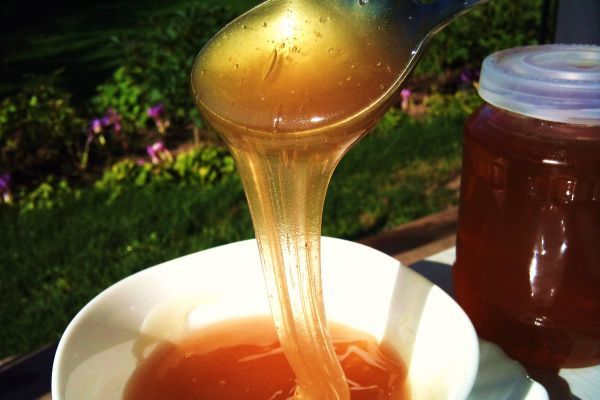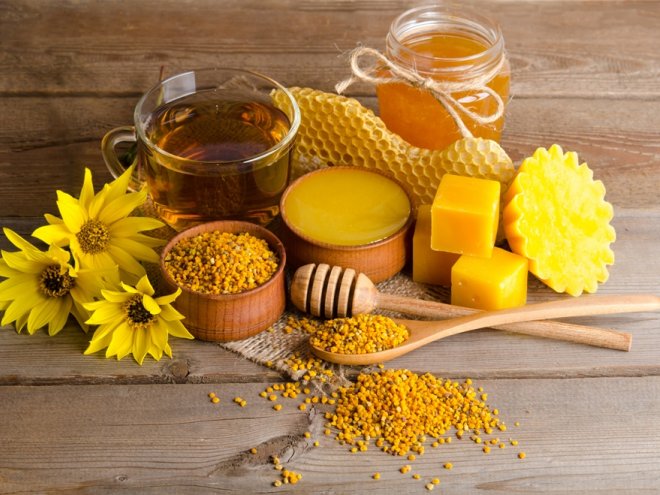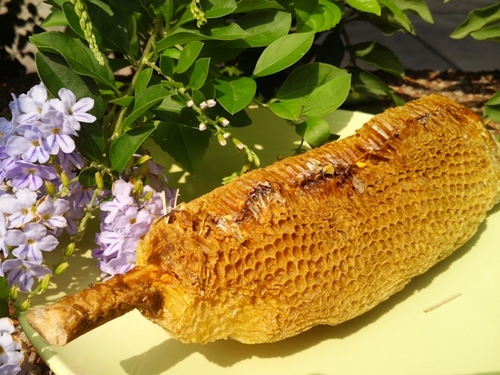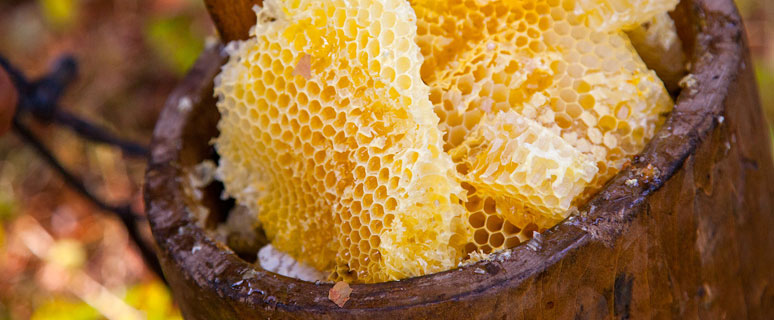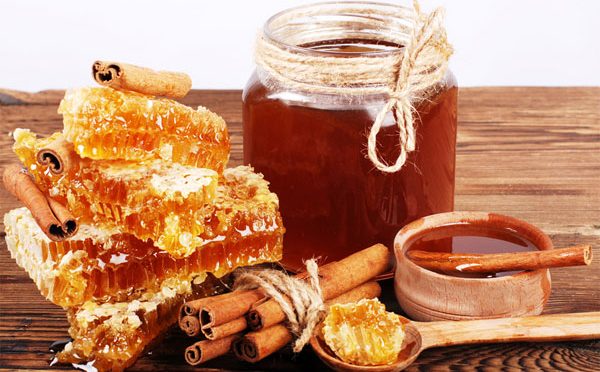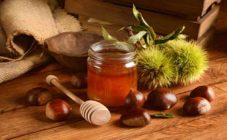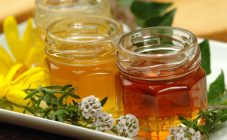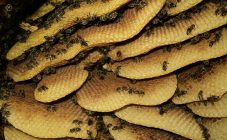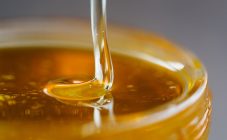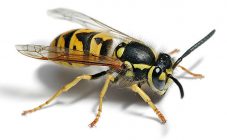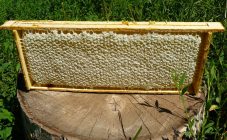Content:
Of all beekeeping products, wild honey is a very rare variety. The main territory of its production is Bashkiria, the Urals, the Carpathians. Wild bees live there, arranging their nests in tree stumps and hollows. Another name for this product is boron honey.
Features, differences from other varieties
The main feature of wild honey is that its miners are not at all cultivated bees in the apiary, but wild ones that live in the forest or in the mountains. They are hardy insects that can tolerate cold. They live in very numerous families numbering thousands of individuals. Since they have to defend themselves and the colony in the wild, they are characterized by violent aggression. Wild bees' nests can be destroyed by forest animals that love nutritious honey.
Product extraction conditions
People have also been hunting for their product for a long time. Borting is known as a type of occupation, which consists in finding habitats for forest and mountain bees and removing honey from them. After that, insects have to build a nest again (fight). What should wild bees look like? They are distinguished from ordinary ones by a peculiar dark gray color. The family collects 5 to 15 kg of sweet product. Bees show endurance and try to work all day long. Bad weather doesn't stop them. If we consider the middle latitudes, the season lasts no more than 3 weeks, corresponding to the flowering of linden.
Over time, people began to make boards themselves, having learned to choose a place for this. The family of insects in them is usually settled in another year after construction. If such nests were found in the rocks, a person equipped them, creating conditions for families to expand. Nowadays, mountain or forest honey is rarely found in nature. Urbanization is to blame for the decrease in the area. After all, insect families are located very far from civilization, it is not always possible to get to them.
Variety differences
If you see such a product for sale at a low price, there is a very high chance of buying a fake one. In addition to its significant cost, natural honey can be recognized by its smell, color and taste. What color of forest natural honey can be considered the same wild variety?
It is distinguished by the following features:
- In the composition, a specific honey plant cannot be identified. It is a mixture of nectar from various plants.
- Very intense aroma.
- Somewhat tart taste with richness.
- Dark brown in color, beautiful to look at.
- Viscous structure.
Composition of honey
Wild honey is characterized by a unique composition that is not similar to other varieties. The organic acids and hormonal components included in it are very useful for the body. The mass contains particles of wax, bee bread, propolis - natural remedies. The sweet product of wild insects is rich in minerals, enzymes and active ingredients.
Their list is as follows:
- fluorine;
- manganese;
- iron;
- calcium;
- iodine;
- copper;
- zinc.
There are also ascorbic acid, vitamins B, E, K and others. The description of bead honey is not limited to its chemical composition.
The bees provide the following foods:
- wax;
- pollen;
- bee venom;
- drone brood;
- backing (honeycomb caps);
- royal jelly;
- perga.
The useful composition of the components and impregnations of these beekeeping products makes honey very valuable. The sweet taste is formed from glucose, sucrose and fructose.
Useful properties and advantages
Regular consumption of products created by wild bees brings great benefits to the human body. So the pollen contained in the honey composition gives anti-inflammatory properties, has a diuretic, choleretic effect and is an antioxidant. Bee venom gives an analgesic effect for rheumatism, osteochondrosis. Almost any honey helps fight germs.
Wild view – is no exception, the following list of useful characteristics is listed behind it:
- Promote the strengthening of the body.
- Bringing blood composition back to normal.
- Improving metabolism, elimination of toxins.
- Improving immunity.
- The endocrine system receives a set of hormones present in the composition.
- After exertion, both mental and physical, he recovers strength.
- It has a calming and beneficial effect on the nervous system.
- Normalizes blood supply to organs and brain, strengthens vascular walls.
- It is used against congestion in the gallbladder and kidney pathologies.
- Improves appetite.
It is noted that this type of honey does not irritate the digestion. Therefore, it is given after operations to restore the body's strength. They also activate the processes of food digestion, appetite. To do this, take honey on an empty stomach in the morning with a glass of water. The metabolic processes are improved by the royal jelly contained in the composition.
You can give the following list of diseases that are treated in folk medicine with wild bee honey:
- Rheumatism.
- Help against infections.
- Cystitis.
- Bowel diseases.
- Tachycardia.
- Bronchitis.
- Flu.
- Rhinitis and sinusitis.
- Headaches.
- Gastritis, stomach ulcer.
- Metabolism in need of normalization.
The product is highly recommended for atherosclerosis, anemia. Compresses are made for eye diseases, as well as on joints. It is an excellent prophylactic agent, an addition to medications. The uniqueness of the composition and small production volumes make it by no means cheap on the market.
Collecting wild honey
Since the honey of uncultivated wild bees is collected only in August, once a year, it turns out to be quite concentrated. After all, the product is infused, the excess moisture is gone. Among the melliferous plants are herbs, wild shrubs and trees. These are hawthorn, thyme, mint, acacia, rosehip, sage and others. Moreover, their flowering is observed in different periods. A bee can collect pollen in all weather conditions, because the total time for collecting products in the season is limited.
How can a person get wild honey? An old craft - bee-keeping, developed when it was necessary to increase the amount of the product. People doing this build hives in tree trunks, making holes in them. They are very careful about the future habitat of forest insects. A source of clean water is needed nearby, near which melliferous plants grow. These are trees: maple, linden, and aromatic herbs.
The location of the exit of their hive is important. It should face south. In the future, honeycombs and grasses will leave housing for bees, which attract them. A properly created monastery in the next two years is likely to be populated by a family of these hardworking insects. Placing it at a certain height will save the nest from bears. When beekeepers collect a sweet product, they leave a part for the continuation of the family.
How to choose the right bead honey
An expensive treat is often counterfeited. When buying airborne honey, how to distinguish the proposed product from a fake? The forest species has a thick consistency.
The following characteristic signs by which it can be determined:
- The color is pleasant, amber with a brown tint.
- The taste is sweet and tart at the same time.
- The smell cannot be compared to anything. It should be distinguished by notes of woody resin and also include herbal aromas that make it stand out from other varieties.
- The price cannot be too low, as the product is very rare.
Liquid and flowing honey should be distinguished from the desired wild variety. If this symptom is accompanied by the usual honey smell, it is better to avoid acquisition. Counterfeiting in this case is very likely. The seller's reliability factor is also important. If this is a proven beekeeper with a known good reputation, you can shop with more confidence.
Terms of use and storage
Some people are allergic to bee products.
Are there any contraindications to this variety:
- Wild honey is not given to children under the age of two.
- And also to persons with individual intolerance. As an allergen, it can cause asthma-type attacks or anaphylactic shock.
- Pregnant women and diabetics should use it with caution.
It is recommended to keep honey in storage at temperatures from +5 to +7 degrees C. Its beneficial properties can be lost at 40 degrees Celsius or below -30 frost. The wild variety of this product is not heated, protected from sunlight, as well as from light. Opt for glassware. Metal or plastic is less suitable. Air humidity should be 60% or more. Absorption of excess moisture does not threaten the product.
Wild natural honey is a kind of flower. It is he who is loved by the bears in the forest. This product is in great demand due to its environmental friendliness, it is a completely natural product. It is almost impossible for wild bees to include supplements in their diet, as is sometimes done in an apiary. This ensures the purity of the product. The Bashkir and mountain (Carpathian) species are of the greatest value. The full completeness of useful properties can be felt only by tasting wild honey.

